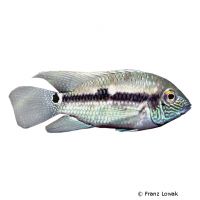Doublespot Acara (Aequidens pallidus)
| Doublespot Acara Aequidens pallidus | |
|---|---|
| Name | Doublespot Acara |
| Name Lat. | Aequidens pallidus |
| Synonym | Acara pallidus |
| Family | Cichlids |
| Family lat. | Cichlidae |
| Order | Cichlids |
| Order lat. | Cichliformes |
| Origin | South America |
| Habitat | Rivers, lakes |
| Diet | Carnivore |
| pH | 6.5-7.5 |
| Behavior | Semi-aggressive |
| Keeping | Pair |
| Care Level | Moderate |
| Reproduction | Substrate spawner |
| Breeding | Moderately difficult |
| Life Span | 5-8 years |
| Protection | No |
| Metric Units | |
| Size | 14 cm |
| Temperature | 22-28 °C |
| Hardness | 1-15 °dH |
| Aquarium | 120 cm / 240 l |
| US Units | |
| Size | 5.5" |
| Temperature | 72-82 °F |
| Hardness | 18-267 ppm |
| Aquarium | 65 gal |
Distribution and habitat
The distribution area of the two-spotted cichlids are the river systems of the middle and lower Rio Negro and after its confluence with the Amazon, they can be found as far as the Uatuma area (Brazil). There they live in rivers and lakes with dense riparian vegetation and in the floodplains.
Maintenance
The aquarium should have a robust border planting, with many hiding places (stones, roots), and offer free swimming space. A substrate of sand or fine gravel and somewhat subdued light (floating plant cover) is ideal.
No ammonia, ammonium and nitrite should be detectable, and the nitrate value should not exceed 100 mg/l. To ensure the water quality and oxygen content, a filter and heater adapted to the aquarium size is required, as well as lighting for the species-appropriate day-night rhythm of the animals.
Diet
The food supply consists of live food, such as daphnia, artemia, mysis, tubifex and red mosquito larvae, which is also accepted without problems in frozen form, plus commercially available frozen special food mixtures, cichlid pellets and high-quality flake and granulate food.
Regular and varied feeding promotes health and increases resistance. Only feed as much as is eaten immediately (in a maximum of 10 minutes).
Behaviour and compatibility
They should be kept in pairs. At spawning time they behave very territorial, therefore keeping several pairs is only recommended in a larger and richly structured tank. They can be well socialized with other not too small fish.
Basically, only compatible fish species with similar demands on water quality and water temperature may be socialized.
Sex dimorphism
In the adult male the genital papilla is larger and pointed, in the female smaller and blunt.
Reproduction and breeding
They spawn on stones or roots (open brooders). Both parents perform brood care (parental family). After two days they take the larvae into their throat sac for mouthbrood care and release the fry after eight days, which are protected by the parents for some time and led to the feeding places in the aquarium before the brood care ends.
Fry must be fed several times a day with special rearing food. Breeding is hardly possible in community tanks, where the fry are easy prey.
Important
The well-being of the fish should be checked regularly. The temperature should be checked daily, the pH, hardness and nitrate value at least every 14 days. A regular partial water change is recommended, even if the pollutant load has not yet reached the upper limit. Sudden changes in water quality should be avoided. Newly introduced fish must be accustomed slowly to the water in the aquarium.
Further literature can be found in your pet store.
References
Text: Werner Winter; Image: Franz Lowak
Source: BMELV (1998): Tierschutzgutachten - Haltung von Zierfischen (Süßwasser); RIEHL & BAENSCH (2006): Aquarien Atlas Bd. 1, Mergus Verlag; ENGELMANN (2005): Zootierhaltung - Tiere in menschlicher Obhut: Fische, Verlag Harri Deutsch
- Gemäß § 21 Abs. 5 Tierschutzgesetz idgF
